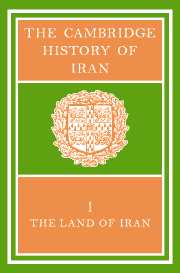Book contents
- Frontmatter
- PART 1 THE LAND
- 1 PHYSICAL GEOGRAPHY
- 2 GEOLOGY
- 3 GEOMORPHOLOGY
- 4 THE ORIGIN OF THE ZAGROS DEFILES
- 5 CLIMATE
- 6 SOILS
- 7 HYDROGRAPHY
- 8 VEGETATION
- 9 MAMMALS
- 10 ZOOGEOGRAPHIC ANALYSIS OF THE LIZARD FAUNA OF IRAN
- 11 ORNITHOLOGY
- PART 2 THE PEOPLE
- PART 3 ECONOMIC LIFE
- PART 4 CONCLUSION
- Bibliography
- Conversion Tables
- Fig. I. Iran: physiographical.
- Plate Section
- Fig 85. Soil potentiality map of Iran.
- References
7 - HYDROGRAPHY
from PART 1 - THE LAND
Published online by Cambridge University Press: 28 March 2008
- Frontmatter
- PART 1 THE LAND
- 1 PHYSICAL GEOGRAPHY
- 2 GEOLOGY
- 3 GEOMORPHOLOGY
- 4 THE ORIGIN OF THE ZAGROS DEFILES
- 5 CLIMATE
- 6 SOILS
- 7 HYDROGRAPHY
- 8 VEGETATION
- 9 MAMMALS
- 10 ZOOGEOGRAPHIC ANALYSIS OF THE LIZARD FAUNA OF IRAN
- 11 ORNITHOLOGY
- PART 2 THE PEOPLE
- PART 3 ECONOMIC LIFE
- PART 4 CONCLUSION
- Bibliography
- Conversion Tables
- Fig. I. Iran: physiographical.
- Plate Section
- Fig 85. Soil potentiality map of Iran.
- References
Summary
Since antiquity the distribution and intensity of human activity in Iran have always reflected the availability of water, either on the surface, or beneath it within the reach of primitive technology. Iran's most glorious days were inaugurated by achievements in water control that were incredible for their age, and her decline resulted as much from a misunderstanding of the implications of complete water control as from the more easily comprehended political and physical disasters brought by Arab rule and successive Mongol conquests. It is undeniable that contemporary Iran is among the leanest of countries by virtue of her climatic and hydrographic deficiencies. In honesty one must admit that her most legendary oases are verdant only by contrast with the fearful landscapes around them, and their sparseness of water is often disappointing to foreigners who are unacquainted with the desolation of their hinterland. In this desiccated country the congruence between procurable water and population density is maintained even where water is in excess of need. Since the collapse of the irrigation economy of ancient Khūzistān, the marshy coastal plain between the Alburz mountains and the Caspian Sea, though malarial, ill-famed, and isolated from the main currents of Iranian life, has continued to support the greatest concentrations of humanity between the Black Sea and the Indus valley.
GENERAL CONSIDERATIONS
Iran's most obvious hydrographic problems are compounded of the disadvantage of scanty and highly seasonal precipitation, and a surface configuration which tends to concentrate moisture on the periphery of the country, leaving its vast heart an area of irreconcilable sterility. South of the Alburz mountains there is no hope of rain during the summer months, when streams wither and the land is parched. Frontal precipitation occurs between October and May, its distribution and quantity being conspicuously related to elevation and exposure.
Keywords
- Type
- Chapter
- Information
- The Cambridge History of Iran , pp. 264 - 279Publisher: Cambridge University PressPrint publication year: 1968
References
- 2
- Cited by



